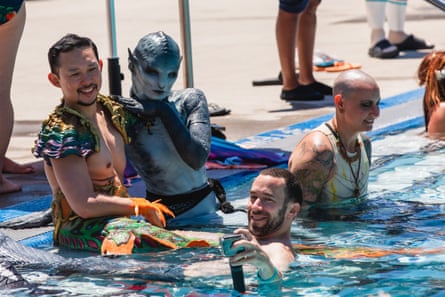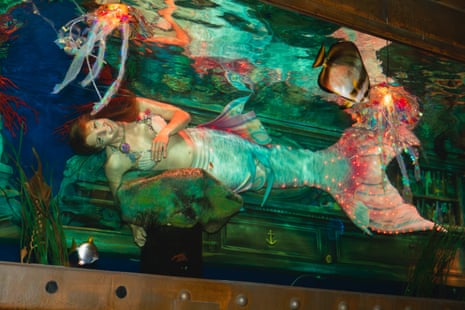Last weekend, around a community pool near Sacramento, flippers were being unpacked, glowing bubble crowns secured to wigs, and glittery eye makeup donned: the annual US meeting of mermaids was underway.
Hundreds gathered for the California Mermaid Convention: a three-day celebration of the increasingly popular practice of “mermaiding”. Part cosplay, part athletic endeavor, the hobby ranges from casual dress up to certified divers who strap on “monofins” and swim together in a pool or the open ocean.
Above all, mermaids are an inclusive community working to maintain its magic as participation grows, thanks in part to easily accessible fins and excitement about Disney’s reboot of The Little Mermaid.
Billed as the world’s longest running mermaid gathering, the California Mermaid Convention began as an informal event among friends in 2011 and has grown into a full weekend tailored to merfolk – the gender-neutral term for mermaid enthusiasts – of all varieties. Attendees range from professionally trained mermaids who perform at underwater shows to “guppies” – the community term to those new to the mer-world.
Merfolk came from all over the world, with one mermaid saying she took four different flights from her home in northern Canada. Around a pool for group swimming in fins, there were panels, underwater photoshoots, workshops, and vendors for all kinds of mermaid memorabilia.
Events kicked off on Friday night at Dive Bar – a mermaid-centric club that hosts nightly underwater shows. Attendees dressed in mermaid gear (minus the fins) sipped on cocktails, oohed and aahed at the swimming performers, and participated in a contest that honored participants whose creations “best showcased their mer-sonalities”.
On Saturday, the community pool party was infused with an overwhelming air of support and joy – with attendees hyping up each other’s outfits with a popular refrain of “Yes, fish!” At the day’s close, merfolk dressed up in their finest costumes for the Bubble Ball, a kind of mermaid prom where couples slow danced to The Little Mermaid’s Kiss the Girl and a conga line of jellyfish, pirates, mermaids and one person in a shrimp costume weaved around the dance floor. On Sunday, a mermaid parade through Old Sacramento – the event that first launched the convention – closed out the magical weekend.

Several of the mer-people declined to share their real names, preferring to keep their “mer-sonas” separate from their daily lives. One such attendee – Merman Eldoris – flew to the convention from his home base in the south-east of the United States where he is a student. He described his arrival to the world of mermaiding as a magical experience.
“When I was very young I would jump into the pool with my feet tied together and tell everyone I knew that I used to be a mermaid in another life,” he explained. Years later, he came across a YouTube video about how to make a monofin, or mermaid tail, and discovered he could actualize his dream.
Eldoris, who is genderqueer, said the community is overwhelmingly inclusive – a place that allows queer, trans, and neurodivergent people to “settle into themselves”. He had been exploring the world of mermaiding for nearly a decade when he finally found a local “pod” – a loose term for merfolk who swim together.
“The first time that I met up with mermaids and swam with them, I remember realizing, wow, this is the first place I’ve truly felt like I belonged – where I didn’t have to be anything other than who I was,” he said.
That ethos is one the community is pushing to retain as it gains more mainstream popularity. A new Netflix documentary focusing on the community is further exposing it to the mainstream, and merfolk say the recent release of the new Little Mermaid film should spark an additional influx of interest.

Meanwhile, the world’s leading scuba diving training organization, Padi, introduced a mermaid course in 2020 focusing on mermaid-specific diving skills like swimming with a monofin and breath-holding techniques. It now offers seven levels of mermaiding courses – from introductory to professional Mermaid Instructor Trainer – around the world. Padi reports it has seen mermaiding certifications increase more than 400% in the last few years, with the “mermaid economy” growing more quickly than scuba diving in some locations, including China.
“As we start to get more press we are having a lot of conversations as a group,” Eldoris said. “How do we keep people safe? How do we stay positive? How do we invite new people in while making sure this community stays as sacred and inclusive as it has been?”
‘If you want to join us, we’re going to protect you’
Mermaid costuming and performance has been around for decades, with famous burlesque dancers of the 1940s and 50s specializing in underwater shows. Aquatic parks including Sea World hosted mermaid shows in the 1980s and 1990s, and some persist – including those at the Florida park Weeki Wachi Springs, which have been running continuously since the 1940s.
But mermaiding, in the community sense, is relatively new – and the practice can seem daunting to outsiders. Its increasing popularity in recent years has been fueled by social media getting the word out and the rise of more affordable monofins. In the past, even the cheapest fins cost nearly $1,000. Attendees described cobbling together fins in their early days from what they could find – hand sewing or stapling tails to get started – one woman said she used plastic from a trash can to make her first tail. Today, custom fins can still cost thousands of dollars, while functional swimming fins can be had for as little as $30.
Although the surge of interest has made the community feel self protective, mer-folk are largely thrilled about Disney’s live-action Little Mermaid film, which features a Black lead actor as Ariel. For many, the casting represents a mainstream departure from the historical mythical image of the mermaid as a thin, white woman.
“Representation is everything,” said Merman Onyx, a conference attendee and panelist. He said he has publicized his own experience in the mermaiding community as a means to increase visibility of Black men in the fantasy world. “I wanted to step into these spaces where a lot of us don’t feel welcome and open that door for others.”
Bailey’s casting as the Little Mermaid sparked racist outrage, sparking the hashtag #NotMyAriel and a series of predictable Fox News segments about “woke” Disney culture. But merfolk say such responses stand in stark contrast to the reality of the mermaiding community, where inclusivity has long been a top priority.
“The diversity is already here, and it has been here,” Onyx said. “If you want to join us, we are going to protect you no matter what – you’re one of us.”
The convention itself advertises the mermaiding community as a “very diverse and inclusive one”. Its strict code of conduct states it is meant to foster a safe experience for attendees “regardless of gender, gender identity and expression, age, sexual orientation, disability, physical appearance, body size, race, ethnicity, religion (or lack thereof), or technology choices”. Throughout the day, mermaids over the age of 60 splashed alongside children in fabric tails inside the pool. There was a diversity panel about inclusive mermaiding, and a number of group photos for mer-affinity groups including mermaids of color, trans and non-binary mermaids, and fat mermaids.

Chè Monique, a mermaid based in the DC area, founded the Society of Fat Mermaids in 2018 and was drawn to a community where she said she always felt celebrated. She found the whimsical nature of mermaiding lends itself to expansive representations of many identities – and a desire to keep the space as safe as possible.
“The mer-community is ultimately made up of adults doing very playful, creative stuff,” she said. “You’re already letting your personal vulnerability show, and letting your weird out, so it makes sense to want to protect your larger community,” she said.
Orchid Cavett, a 69-year-old mermaid, said she has experienced a lot of ageism in her daily life that she does not find in the mermaiding community. When she is dressed as Grandmer Orchid – her mersona – she finds more freedom to share joy and educate people.
“When you are in costume, people always smile at you – they are always happy to see you,” she said. “This world is pretty grim right now – there’s a lot of division. To me, there is such value in bringing joy into the world. Mermaiding is about coming together, all shapes and sizes, and being able to share that magic.”

